The Environmental Protection Agency waited a month to consult some of its top experts about the risk of dangerous chemical exposure around East Palestine, Ohio, following the fiery derailment of a Norfolk Southern train hauling toxic materials, internal emails show.
That delay left at least two EPA scientists surprised and concerned. And it occurred while the agency was deferring to the railroad giant and its web of contractors to spearhead environmental testing, including crafting protocols for sampling soil, water and air for chemicals — a move many saw as a glaring conflict of interest.
HuffPost obtained internal agency communications via a Freedom of Information Act request. Paul Van Osdol, a reporter at WTAE TV in Pittsburgh, Pennsylvania, first reported some of the documents.
The Norfolk Southern train derailed in East Palestine on Feb. 3 while hauling toxic and flammable materials, including hundreds of thousands of pounds of vinyl chloride, a common organic chemical used in the production of plastics and that’s been linked to several types of cancer.
The wreckage burned for several days, and on Feb. 5, authorities ordered an urgent evacuation for everyone within one mile of the site due to the risk of what they described as “a catastrophic tanker failure which could cause an explosion with the potential of deadly shrapnel traveling up to a mile.” To prevent such an explosion, the local fire chief, Norfolk Southern and other state and local officials conducted what they called a “controlled” vent and burn of the vinyl chloride on Feb. 6, three days after the crash, sending plumes of thick black smoke billowing into neighboring communities.
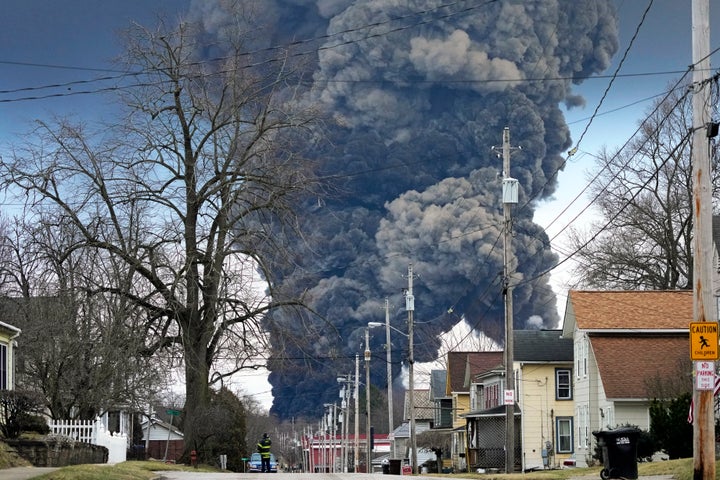
Judith Enck, a former EPA regional administrator, called the email communications “stunning.”
“This illustrates that the top scientists were kept out of the loop,” Enck said. “I was always very puzzled why the EPA would allow this open burning of vinyl chloride if they had consulted with their scientists. And it appears that they did not.”
EPA officials confirmed to HuffPost that the agency did not direct and was not consulted about the so-called “controlled burn.” They said EPA’s role at that time was to “coordinate and conduct air monitoring from outside the evacuation area,” yet acknowledged the agency never considered monitoring for dioxins, a family of extremely toxic compounds that can form when chlorinated chemicals like vinyl chloride combust.
“EPA did extensive scientific reviews early on and determined that significant increased community risk to dioxin exposure was unlikely,” an EPA spokesperson said via email.
Enck and Stephen Lester, a toxicologist and the science director for the Center for Health, Environment and Justice, who both reviewed the emails and have closely followed the response in East Palestine, accused the agency of misjudging the dioxin risk and failing to uphold its mission to protect public health.
“Virtually every step of this process they’ve done it wrong,” Lester said. “I’ve been doing this for more than 40 years. I’ve seen EPA’s work at hundreds of sites around this country, contaminated sites, and this is as bad as I’ve ever seen them be. And that is shocking to me.”
“They created some narrative from the very beginning with regard to the whole dioxin thing, and really the whole thing in general — that the cloud came and went and everybody is OK,” he added. “Reality is not like that. And the reality of what happened there is not like that.”
Internal Unease
Dioxins are considered “persistent organic pollutants,” meaning they take a long time to break down in the environment, and can accumulate in the food chain. They have been linked to numerous serious and potentially deadly health problems, including cancer, developmental and reproductive problems, immune system damage and hormone disruption.
In the days and weeks after the incident, independent experts sounded the alarm about the risk of dioxin exposure in and around East Palestine.
“If you work at EPA, you know that if you burn vinyl chloride, there is a high likelihood dioxin and other toxic contaminants will be formed,” Enck said.
On Feb. 17, two weeks after the derailment, Linda Birnbaum, a toxicologist and former director of both the National Institute for Environmental Health Sciences and the National Toxicology Program, emailed EPA dioxins expert Brian Gullett to ask if he had any information about what kind of air monitoring the agency was doing in Ohio and neighboring Pennsylvania.
“Any measuring for dioxins? PFAS?” she inquired. (PFAS is short for per- and polyfluoroalkyl substances, a family of toxic so-called “forever chemicals.”)
“I’ve not heard anything,” Gullett responded. “Given the mix of chemicals, I’m a bit surprised that I haven’t.”
“We have the ability to sample these plumes using our drone-mounted sampler but it’s too late now, of course.”
- Brian Gullett, a dioxin expert at EPA, in a Feb. 26 email
A week later, Gullett forwarded Birnbaum an update from EPA’s Office of Research and Development, the agency’s scientific research arm, detailing its involvement in the ongoing response. The memo made reference to two unnamed chemicals that were detected at low levels in the plume, but noted that air monitoring had not detected levels of concern since the burn event.
“Thx for sharing,” Birnbaum replied. “Big question - why no [sic] look for dioxins?”
Gullett voiced concern that EPA had missed a narrow window for tracking the movement of any dioxins released in the blaze. In a an email to Birnbaum on Feb. 26, Gullett said it was unclear if anyone considered the dioxin risk before torching the tanker cars, and that while there may be residual dioxin in ashes from the fire, “most of what may have been formed was dispersed throughout the area in the plume.”
“We have the ability to sample these plumes using our drone-mounted sampler but it’s too late now, of course,” he wrote.
“Lots of not-thinking went on!” Birnbaum responded.
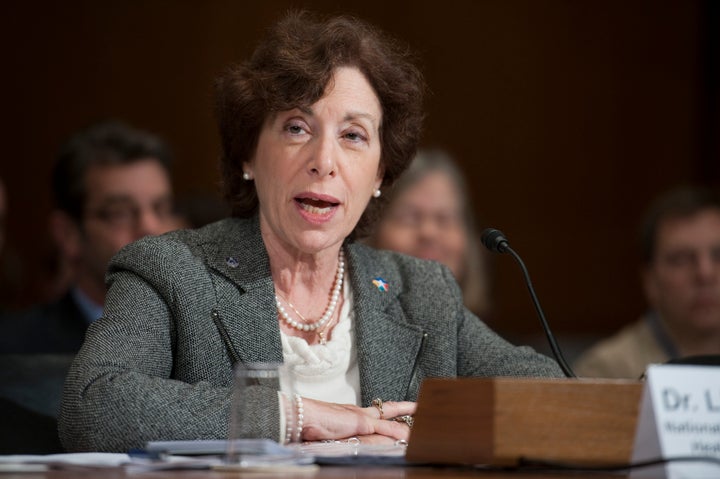
As the emails show, Gullett and several other chemical and environmental monitoring experts within EPA’s Office of Research and Development were not pulled into the disaster response until early March — a full month after the derailment.
“There is no technical ask currently, but I want to put on your radar the potential for requests from [the Office of Research and Development’s Immediate Office of the Assistant Administrator] for technical expertise regarding the East Palestine train derailment,” Gayle Hagler, an environmental engineer at ORD, wrote in a March 1 email to Gullett and three other EPA staff. “You are likely the subject matter experts I would reach out to if technical expertise requests come to [ORD’s Center for Environmental Measurement and Modeling] regarding air emissions/measurements for this incident.”
Gullett, an environmental engineer at ORD’s National Risk Management Research Laboratory, thanked Hagler for the heads-up and said he was “surprised that we haven’t been asked yet.”
Michael Hays, an air quality expert at the ORD lab, wrote in reply to the above email that he was “curious” about the plume released from burning vinyl chloride.
“We can probably do some experiments that will inform about emissions and subsequent community exposures. I do hope that it was cleaner than burning PVC,” Hays wrote.
Polyvinyl chloride is a material used in PVC piping and other plastics. The EPA has identified the production of vinyl chloride and PVC as possible sources of dioxins.
Hays later sent along a picture of the massive plume of black smoke towering over East Palestine — a dramatic scene that Gullett likened in a subsequent email to the Deepwater Horizon explosion and oil spill in the Gulf of Mexico.
“Wow!” Lara Phelps, director of CEMM’s Air Methods and Characterization Division, wrote back. “I have really been surprised no one has contacted any one from CEMM yet, but it appears it might be close.”
Gullett and Birnbaum continued to privately discuss what they clearly viewed as agency missteps. On March 3, Birnbaum emailed Gullett a news article about EPA directing Norfolk Southern to test for dioxins.
“If they only test at the derailment site they will miss the plume which is where the dioxins would be,” Birnbaum wrote.
“I just got pulled in last night,” Gullett replied, adding that he was scheduled to meet with EPA’s Region 5 and other agencies involved in the disaster response.
Lester, the expert toxicologist at CHEJ, described Gullett a “key dioxin scientist” and said it is “inexcusable and unconscionable” that he and others were not consulted.
“This correspondence makes it clear that the people at EPA with the most dioxin expertise and experience were an afterthought in the EPA’s response to the accident and the decision to intentionally burn the vinyl chloride,” Lester said. “I truly believe the response to the derailment would have been very different if public health scientists with an understanding of the toxicity and subsequent health risks posed by burning the [vinyl chloride] were included in the decision process.”
Lester noted it is EPA’s Office of Research and Development that has spent the last several decades studying, inventorying and developing risk analyses for dioxins.
“If dioxin is to be addressed by the agency in a situation like this, they would need to be included in the decisions about what to look for, when to look,” he said. “They have an enormous amount of experience and understanding about dioxin.”
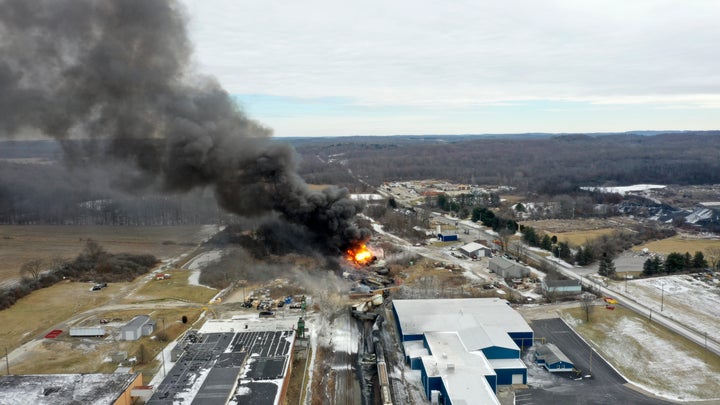
EPA confirmed to HuffPost that ORD’s involvement through February was limited to one of its divisions, the Center for Public Health and Environmental Assessment, providing inhalation exposure values for chemicals of concern. Those so-called “provisional advisory levels” are “used to inform risk-based decision making during a response to environmental contamination involving hazardous chemicals,” according to EPA’s website. It wasn’t until March 1 that EPA activated ORD’s “Reachback for Emergency Response” program, giving on-site responders access to additional resources within ORD.
Gullett did not respond to HuffPost’s request for comment. An EPA spokesperson said that although Gullett “has been involved in some aspects of the response, he was not part of the dioxin-sampling workgroup and the correspondence with [Birnbaum] represents only his opinion.” The agency confirmed Gullett ultimately joined the response effort on March 3 to provide technical expertise on the potential for dioxins entering the Ohio River and impacting drinking water.
“As the response transitioned from an emergency phase to the clean-up and remediation phase, the agency engaged additional programs and expertise to best protect the health and safety of the community,” a spokesperson said.
‘Dioxin Was Never Brought To The Table’
The emails offer a behind-the-scenes look inside the EPA that could help explain the agency’s initial resistance to looking directly for dioxins.
At a news conference in late February, Debra Shore, the administrator of EPA Region 5, explained that it would be hard to connect any dioxins detected in the community to the derailment.
“We don’t have baseline information for dioxins,” Shore said. “They are ubiquitous in the environment. They can be caused by wildfires, by backyard grilling, by a host of other normal activities in human life. Without that information, it would be hard to attribute any level to the derailment.”
Experts at the time criticized that explanation, noting among other things that the public has the right to know about dioxin exposure regardless of the source. Shore’s comments came more than a week after Ohio’s two senators — Democrat Sherrod Brown and Republican J.D. Vance — wrote a letter to EPA Administrator Michael Regan requesting immediate and long-term dioxin testing in and around the crash site. In a response letter on March 2, Regan noted that in response to community concerns about dioxins, state and federal agencies had been sampling for so-called “indicator chemicals” that would signal a potential release of dioxins from the derailment, and that those monitoring efforts “suggested a low probability for release of dioxin from this incident.”
It wasn’t until March 3, after weeks of mounting public pressure and concern, that EPA finally ordered Norfolk Southern to sample directly for the class of chemicals. The agency subsequently reviewed and signed off on a plan to test for dioxins in soil on March 7 — a testing regime that railroad contractor Arcadis created — and oversaw the sampling that Arcadis conducted in March and early April at and around the derailment site. Lester and other experts told The Guardian at the time that the plan was flawed and “unlikely to give a complete picture” of contamination because sampling focused on areas with visible signs of ash, rather than being conducted in a grid pattern, and was limited to soil within a two-mile radius of the crash site.
And by then, of course, the smoke plume was long gone.
Mark Durno, EPA’s onsite coordinator for the response in East Palestine, told HuffPost in an interview that the agency did not consider sampling the smoke plume for dioxins. He said dioxin testing is not typical during this kind of chemical burn incident.
“In this case, dioxin was never brought to the table,” he said, adding that the agency was more concerned about testing for primary combustion products like phosgene and hydrogen chloride. Those compounds “never tested that high in the environment, so we felt pretty good about secondary and tertiary byproducts moving forward,” he said.
The agency’s early presumption that there was a low dioxin risk, he added, has largely been proven correct by soil sampling that took place in March and April. Out of more than 140 sites tested for dioxins in and around East Palestine, fewer than 10 had levels above 50 parts per trillion (ppt), according to Durno.
“The levels of dioxin contamination are largely in the low range — anywhere from 1 part per trillion up to roughly 20 parts per trillion,” Durno said. “We did have some outliers that were above 50 parts per trillion, but every single one of those outliers were either associated with a commercial industrial property or a public right of way next to a roadway, typically next to highways.”
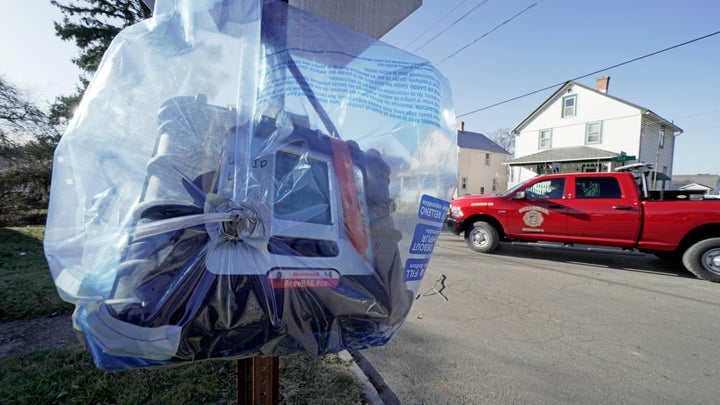
The highest dioxin concentrations — around 700 ppt — were found in waste soil that was hauled from East Palestine to an Indiana landfill. Independent testing by scientist Scott Smith detected dioxins at much higher levels than EPA. The federal agency has questioned Smith’s methodology, WKBN-TV in Ohio reported in August.
EPA considers anything below 1,000 ppt in residential areas to be safe; certain states have cleanup thresholds in the double digits. But it’s important to note that the federal standard has remained unchanged since the late 1980s. In 2010, citing the best available science on cancer and health risks associated with dioxins, the EPA under President Barack Obama recommended lowering cleanup thresholds to 72 ppt in residential soil and 950 ppt for industrial sites, and floated lowering them to a mere 3.7 ppt and 17 ppt, respectively. The Obama administration never moved forward with the draft recommendations.
“If [the Obama administration] did then they would have had a huge issue of how do we deal with this number because it’s so low,” Lester said. “What they did is they just ignored it, they never finalized it. But the reality is if you don’t believe the number, then what does it say about your risk assessment process, and all the other numbers that you use for other chemicals using the same process?”
Along with not signing off on the burning of tanker cars, EPA was caught off guard by the volume of what was ultimately set ablaze. On the Sunday prior to the burn, the agency was anticipating only one car of vinyl chloride would be torched. But by the following morning, the number jumped to five, according to Durno.
“If there were more time to react to get other resources on the ground, I would have liked to have had more air monitoring networks even further downwind,” he said. “But on such a tight time frame, there’s no way we could have mobilized those resources.”
Durno told HuffPost he has spoken with Gullett on several occasions as part of the ongoing response, and that Gullett never brought up the concerns and ideas he laid out in his emails. But Durno voiced support for exploring the use of drones for dioxin monitoring in the early stages of similar large-scale disasters in the future.
“I think that would be a really good discussion for our technical teams when we get to the lessons-learned phase of this,” he said. “We’re still working 12- to 14-hour days, every day, out here. We’re still focused on the cleanup. As we start to Monday morning quarterback this response down the road, that is certainly something that we can consider on something this large.”
‘EPA Dropped The Ball’
In an interview with HuffPost, Birnbaum said she’s known Gullett for years and considers him a “guru” on chemical incineration and dioxins. That EPA didn’t immediately contact him is “symptomatic” of a broader problem with federal emergency responses, she said.
“Whether it’s an industrial accident or a natural occuring emergency, like the terrible wildfires or flooding, we don’t have a good way of immediately activating appropriate protocols to do what needs to be done,” Birnbaum said.
The overall risk of dioxin exposure has declined dramatically in recent decades, thanks to regulations and controls on industrial incineration and the use of certain pesticides. But chemical accidents occur regularly in the U.S. — once every two days on average, according to an estimate from the Coalition to Prevent Chemical Disasters.
“In general, dioxin in us and in the environment have gone way down,” Birnbaum told HuffPost. “But when you have an uncontrolled site, then they can go up and it needs to be followed.”
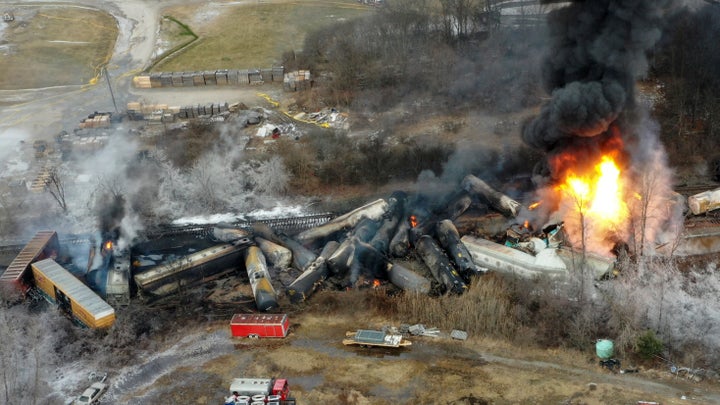
Birnbaum suspects some of EPA’s deference to the railroad is a symptom of deep cuts over the years. She called EPA a “stovepipe” organization that is “horrifically underfunded and understaffed.”
For Enck, the former EPA regional administrator, the emails shine new light on what she views as a bungled EPA response — not preventing the burning of vinyl chlorides, dragging its feet on dioxin testing and ultimately letting the railroad, the party responsible for the chemical disaster, lead that testing effort through its contractor.
At a National Transportation Safety Board hearing in June, two representatives of OxyVinyls, the company that manufactured the vinyl chloride on board the train, told investigators that they never saw signs of a polymerization reaction that would cause the tank cars to explode, and repeatedly relayed that view to Norfolk Southern. Enck said standard procedure in a derailment incident like this is not to drain vinyl chloride from tank cars and burn it, but rather to seal off cars and bring in vacuum trucks to remove the materials.
“That large black toxic plume was likely loaded with toxic chemicals and even though EPA has the ability to test the plume, they opted not to,” Enck said. “The public health implications for thousands of residents of Ohio and Pennsylvania are significant. This open burn did not have to happen. And then the EPA dropped the ball and did not test for the obvious contaminants. It is heartbreaking and should never happen again.”
Enck stressed the significance of Birnbaum raising her concerns with EPA staff. Enck said the former NIESH director “is to environmental toxicology what Bruce Springsteen is to guitar playing.”
Enck, Birnbaum and Lester all agree EPA should have immediately launched a dioxin monitoring effort. That it didn’t, instead waiting a month to order Norfolk Southern to do it, casts doubt over the results of the railroad-led soil sampling, Enck and Lester said.
“They only tested the soil and by the time they tested there were heavy rains and snow melt and you are not likely to find anything on the surface or even a few inches down,” Enck said. “So their findings are not surprising.”
“This has been a situation where EPA from the first moment has been attempting to manage the situation, not investigate it...They should be embarrassed in how they handled this.”
- Stephen Lester, a toxicologist and the science director for the Center for Health, Environment and Justice
In his more than four decades of experience working on contaminated sites, Lester said he’s never seen EPA give a company such carte blanche to run the show. He said he has a hard time believing the dioxin sampling results to date, given how little the EPA says have been found and the railroad’s methodology, and is in the midst of reviewing the data for himself. He called the broader response in East Palestine an “egregious” example of the agency failing in its mission to safeguard public health.
“This has been a situation where EPA from the first moment has been attempting to manage the situation, not investigate it, not address the questions that the public has in general, and certainly the victims who were exposed have specifically,” he said. “They should be embarrassed in how they handled this.”
“I think if the public hadn’t started asking about dioxins, you would never have heard from the agency,” he added. “I truly believe that.”
Asked about the criticisms of independent experts, EPA said it has been on the ground in East Palestine for seven months “working around the clock to protect the health of nearby communities from the mess that Norfolk Southern created.”
“If any outside expert has credible science to show that people are in danger, we stand ready to examine that science and engage constructively, as we’ve done with a host of other advocates and community representatives,” an EPA spokesperson told HuffPost.
